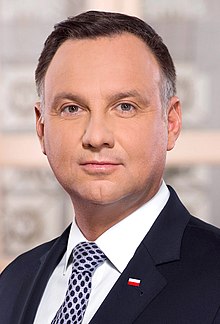President of Poland
The President of the Republic of Poland (Polish: Prezydent Rzeczypospolitej Polski, shorter form: Prezydent RP) is the head of state of Poland. Their rights and obligations are determined in the Constitution of Poland. The president heads the executive branch. In addition the president has a right to dissolve parliament in certain cases, veto legislation and represents Poland in the international arena.
| President of the Republic of Poland Prezydent Rzeczypospolitej Polski | |
|---|---|
 | |
| Style | Mr. President His Excellency |
| Member of | National Security Council National Development Council |
| Residence | Presidential Palace |
| Seat | Warsaw, Poland |
| Appointer | Popular vote |
| Term length | Five years renewable once |
| Constituting instrument | Constitution of Poland |
| Formation | 11 December 1922 (original)19 July 1989 (current) |
| First holder | Gabriel NarutowiczWojciech Jaruzelski (current form) |
| Salary | ~€68,000, annual[1][2] |
| Website | http://www.prezydent.pl |
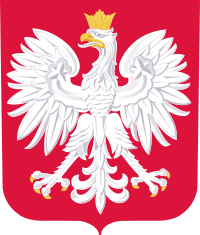 |
|---|
| This article is part of a series on the politics and government of Poland |
|
|
Related topics
|
|
|
History
The first president of Poland, Gabriel Narutowicz, was sworn in as president of the Second Polish Republic on 11 December 1922. He was elected by the National Assembly (the Sejm and the Senate) under the terms of the 1921 March Constitution. Narutowicz was assassinated on 16 December 1922. Previously Józef Piłsudski had been "Chief of State" (Naczelnik Państwa) under the provisional Small Constitution of 1919. In 1926 Piłsudski staged the "May Coup", overthrew President Stanisław Wojciechowski and had the National Assembly elect a new one, Ignacy Mościcki, thus establishing the "Sanation regime". Before Piłsudski's death, parliament passed a more authoritarian 1935 April Constitution of Poland (not in accord with the amendment procedures of the 1921 March Constitution).[3] Mościcki continued as president until he resigned in 1939 in the aftermath of the German Invasion of Poland. Mościcki and his government went into exile into Romania, where Mościcki was interned. In Angers, France Władysław Raczkiewicz, at the time the speaker of the Senate, assumed the presidency after Mościcki's resignation on 29 September 1939.[4] Following the fall of France, the president and the Polish government-in-exile were evacuated to London, United Kingdom. The transfer from Mościcki to Raczkiewicz was in accordance with Article 24 of the 1935 April Constitution.[5][6] Raczkiewicz was followed by a succession of presidents in exile, of whom the last one was Ryszard Kaczorowski.
In 1944–45 Poland became a part of Soviet-controlled central-eastern Europe. Bolesław Bierut assumed the reins of government and in July 1945 was internationally recognized as the head of state. The Senate was abolished in 1946 by the Polish people's referendum. When the Sejm passed the Small Constitution of 1947, based in part on the 1921 March Constitution, Bierut was elected president by that body. He served until the Constitution of the Polish People's Republic of 1952 eliminated the office of the president.[7]
Following the 1989 amendments to the constitution which restored the presidency,[8] Wojciech Jaruzelski, the existing head of state, took office. In Poland's first direct presidential election, Lech Wałęsa won and was sworn in on 22 December 1990. The office of the president was preserved in the Constitution of Poland passed in 1997; the constitution now provides the requirements for, the duties of and the authority of the office.
Election
The President of Poland is elected directly by the people to serve for five years and can be reelected only once. Pursuant to the provisions of the Constitution, the President is elected by an absolute majority. If no candidate succeeds in passing this threshold, a second round of voting is held with the participation of the two candidates with the largest and second largest number of votes respectively.
In order to be registered as a candidate in the presidential election, one must be a Polish citizen, be at least 35 years old on the day of the first round of the election and collect at least 100,000 signatures of registered voters.
Powers
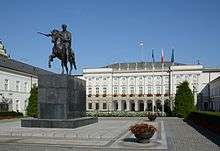
The President has a free choice in selecting the Prime Minister, yet in practice he or she usually gives the task of forming a new government to a politician supported by the political party with the majority of seats in the Sejm (usually, though not always, it is the leader of that political party).
The President has the right to initiate the legislative process. They also have the opportunity to directly influence it by using their veto to stop a bill; however, a veto can be overruled by a three-fifths majority vote in the presence of at least half of the statutory number of members of the Sejm (230). Before signing a bill into law, the President can also ask the Constitutional Tribunal to verify its compliance with the Constitution, which in practice bears a decisive influence on the legislative process.
In their role as supreme representative of the Polish state, the President has power to ratify and revoke international agreements, nominates and recalls ambassadors, and formally accepts the accreditations of representatives of other states. The President also makes decisions on award of highest academic titles, as well as state distinctions and orders. In addition, they have the right of clemency, viz. They can dismiss final court verdicts (in practice, the President consults such decisions with the Minister of Justice).
The President is also the Supreme Commander of the Armed Forces; They appoint the Chief of the General Staff and the commanders of all of the service branches; in wartime they nominate the Commander-in-Chief of the Armed Forces and can order a general mobilization. The President performs their duties with the help of the following offices: the Chancellery of the President, the Office of National Security, and the Body of Advisors to the President.
Presidential residencies and properties
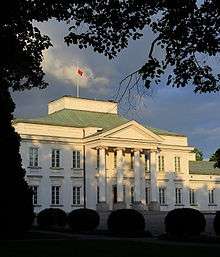
Several properties are owned by the Office of the President and are used by the Head of State as his or her official residence, private residence, residence for visiting foreign officials etc.
- The Presidential Palace in Warsaw is the largest palace in Warsaw and the official seat of the President of the Republic of Poland since 1993. The first presidential tenant was Lech Wałęsa when he moved to the Palace from Belweder in 1994.
- Belweder, in Warsaw, was the official seat of the President until 1993, and is currently owned by the Office of the President as the official residence of the President and is used by the President and the Government for ceremonial purposes. The palace also serves as an official residence for heads of state on official visits to Poland and other important guests.
- Presidential Castle in Wisła in a château built for the Habsburgs as their hunting cottage, which was rebuilt between 1929-1931 and used as recreational residence by President Ignacy Mościcki. Since 2002 it is again a property of the President, restored and opened in 2005 by the President Aleksander Kwaśniewski. It is today a recreational and conference centre for the President and a hotel.
- Residence of the President of the Republic of Poland in Łucień.
- Manor House of the President of the Republic of Poland in Ciechocinek.
- Presidential Residence 'Jurata-Hel' in Hel. The president's Baltic coastal retreat.
Acting President of Poland
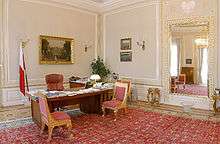
The constitution states that the President is an elected office, there is no directly elected presidential line of succession. If the President is unable to execute his/her powers and duties, the Marshal of the Sejm will have the powers of a President for a maximum of 60 days until elections are called.
On 10 April 2010, a plane carrying Polish President Lech Kaczyński, his wife, and 94 others including many Polish officials crashed near Smolensk-North Airport in Russia. There were no survivors.[9] Bronisław Komorowski took over acting presidential powers following the incident. On 8 July Bronislaw Komorowski resigned from the office of Marshal of the Sejm after winning the presidential election. According to the constitution, the acting president then became the Marshal of the Senate, Bogdan Borusewicz. In the afternoon Grzegorz Schetyna was elected as a new Marshal of the Sejm and he became acting president. Schetyna served as the interim head of state until Komorowski's swearing-in on 6 August.
Former Acting President of Poland:
- Bronisław Komorowski (2010)
- Bogdan Borusewicz (2010)
- Grzegorz Schetyna (2010)
Former Presidents
Within Poland, former presidents are entitled to lifetime personal security protection by Biuro Ochrony Rządu officers, in addition to receiving a substantial pension and a private office. On 10 April 2010, Lech Kaczyński, president at the time, and Ryszard Kaczorowski, the last president-in-exile although not internationally recognized, died in the crash of the Polish Air Force Tu-154 en route to Russia.[10]
Former Presidents of Poland:
- Lech Wałęsa (1990–1995)
- Aleksander Kwaśniewski (1995–2005)
- Lech Kaczyński (2005–2010)
- Bronisław Komorowski (2010–2015)
See also
- Polish presidential elections of
- Prime Minister of Poland
- Polish government in exile
- List of heads of state of Poland
- List of Polish monarchs
- Lists of incumbents
- Naczelnik Państwa
References
- https://zarobki.pracuj.pl/raporty-i-trendy-placowe/ile-zarabia-prezydent-polski
- https://www.xe.com/currencyconverter/convert/?Amount=294000&From=PLN&To=EUR
- Garlicki, Andrzej (2001). "Majowa, marcowa, kwietniowa: Kto nam pisał konstytucje (The valley between the March and the April: We who wrote the constitutions)" (in Polish). Polityki Cyfrowej. Archived from the original on 18 October 2007., which first appeared in Garlicki, Andrzej (2001). "Kto nam pisał konstytucje: majowa, marcowa, kwietniowa". Polityka. 2001 (11): 78, 80, 82.
- Rojek, Wojciech (2004). "Chapter 4: The government of the Republic of Poland in exile, 1945–92". In Stachura, Peter D. (ed.). The Poles in Britain 1940–2000: from betrayal to assimilation. London: Frank Cass. p. 33. ISBN 978-0-7146-5562-8.
- Garliński, Józef (1985). Poland in the Second World War. Houndmills, Basingstoke, Hampshire, England: Macmillan. p. 48. ISBN 978-0-333-39258-4.
- Jędrzejewicz, Wacław, ed. (1946). Poland in the British Parliament 1939–1945 Volume I: British guarantees to Poland to the Atlantic Charter (March 1939 – August 1941). New York: Jósef Piłsudski Institute of America for Research in the Modern History of Poland. p. 318. OCLC 312889779.
- Simons, William B. (1980). "Constitution of the Polish People's Republic". In Simons, William B. (ed.). The Constitutions of the Communist World. Alphen ann den Rijn, the Netherlands: Sijthoff & Noordhoff. pp. 288–310. ISBN 978-90-286-0070-6.
- "Ustawa z dnia 29 gruduia 1989 r. o zmianie Konstytucja Polski Rzeczypospolitej Ludowej (An Act of 29 December 1989 to amend the Constitution of the Polish People's Republic)". Dz.U. 1989 Nr. 75, pos 444 (in Polish). Sejm, Government of Poland. Archived from the original on 15 April 2012.
- "Polish President Lech Kaczynski dies in plane crash ", BBC, 10 April 2010, Retrieved 10 April 2010
- Kulish, Nicholas (10 April 2010). "Polish President Dies in Jet Crash in Russia". The New York Times. Archived from the original on 11 April 2010.
External links
| Wikimedia Commons has media related to Presidents of Third Polish Republic. |
